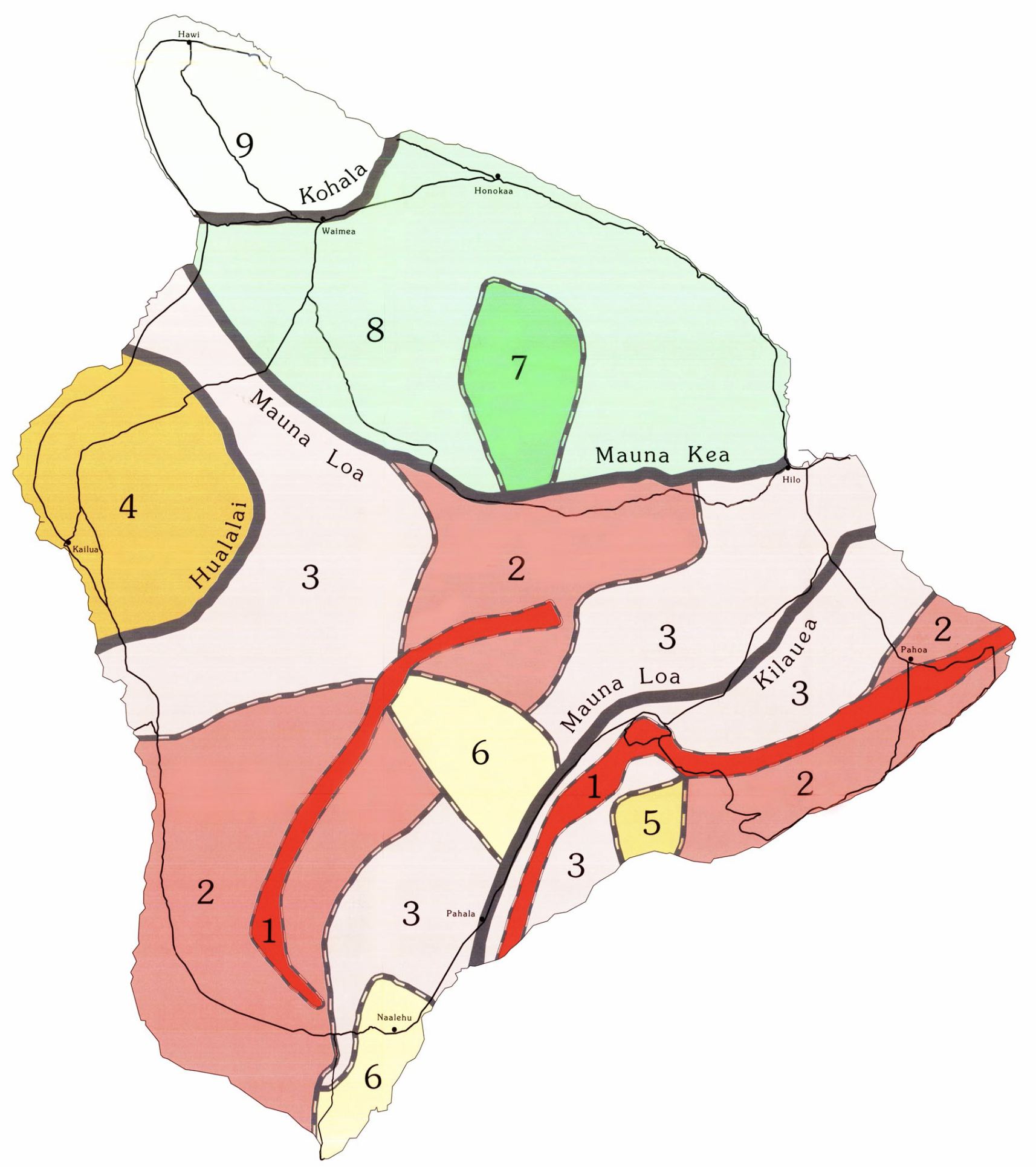Living On An Island Of Volcanoes & Lava
There are always articles about the risks, and there are always risks. There are multiple opinions and predictions about “the big one” coming, and it may be coming. It could be soon or it could be in 2000 years. The island was formed by volcanic activity and there will continue to be activity. Here is a map of the areas where lava has flowed since 1800. When you look at the map, notice that parts of Kona, Kukio (luxury resort community), and the Kona airport are built on rift zones that have had lava flows since 1800.
There are active volcanoes on the island so it is important information to consider. The two most recently active volcanoes that are in the news are Mauna Loa and Kilauea.
The largest active volcano in the world, Mauna Loa, erupted and lava flowed down the northeast rift zone for about 12 days in late 2022, the first eruption since 1984. The lava erupted and flowed from the northeast rift zone, in an area where no communities were at risk.
Kilauea has erupted almost continuously from 1983 until 2018. In 2018 a months-long eruption created slow-moving lava flows that destroyed around 700 homes. Since the 2018 eruption, Kilauea has been erupting sporadically, but only within Halema’uma’u crater as lakes of lava.
Here are FAQs on the USGS site that may help get a clearer picture. Lava zone 1 and 2 will have higher insurance rates and less options for financing based on the long term history of lava flowing.
I often have to remind myself as we drive around the island and see large lava fields (many with homes built on and all around them) that this is a very young island and the lava churning under us created it all, not so long ago.
Here are a few resources for your reading pleasure.
https://www.lovebigisland.com/hawaii-blog/hawaii-volcano-history/
https://www.lovebigisland.com/quick-and-remarkable-facts-about-hawaii/pahoehoe-and-aa/
https://www.lovebigisland.com/big-island-lava-viewing/
Hawaii Lava hazards are a real part of the journey. Hawaii island is comprised of active volcanoes. The United States Geological Survey has divided the island in 9 zones known as lava hazard zones. Zone 1 is considered the highest risk zone based on the degree of the risk of hazard, historical flows, and the geographical layout. Zone 2 is also a high-risk zone based upon the same criteria. As the hazard zone number increases in number the degree of risk decreases. Lava Zone 9 is considered a zone of least risk.
When it comes to purchasing real estate in these high risk areas it’s important to be of the risks that come with owning in these areas as well as the costs associated on a level related to lending and insurance, as well as to the actual physical risk factor associated.
Many buyers are attracted to lava zones 1 and 2. The weather, the lush tropical landscape, the proximity to the ocean and the affordable prices make them very tempting.
Land located in the lava hazard zones 1 & 2 is typically less expensive than any other areas on Hawaii island. In fact, the district of Puna and the district of Kau; both areas designated with lava hazard zones 1 & 2; offer some of the most affordable land in ALL of the island chain. When making a decision to purchase in these areas one must be aware and consider these variables:
- Limited insurers for homeowners insurance and hazard insurance.
- There is the Hawaii Property Insurance Association that offers insurance on homes up to a value of $350,000.00. Any replacement value amount above and beyond $350,000.00 would be provided by Lloyds of London. Typically insurance premiums are much higher than what one would see on a property outside of these high-risk zones.
- Limited financing for residential purchases or construction loans.
- In recent times many lending institutions have completely eliminated programs that they once had for financing in these risk zones. At current, the Federal government does offer a program through Rural Housing development. VA will loan in Lava Zone 1 and 2 with a Lava Insurance Policy for at least the amount of the mortgage. Insurance companies are limiting lava coverage to $350,000 – $450,000.
- As for conventional financing, of the institutions that will loan on them, most are requiring a minimum of 20% down in order to lend on a property in either of these two high-risk zones and lava insurance that covers the amount of the loan.
The lava zones exist to inform us of the potential risk and make informed decisions about where to invest and live. Our listing service (MLS) allows us to filter for lava zones in our searches so let’s talk about the lava zones as we set up your search criteria.




